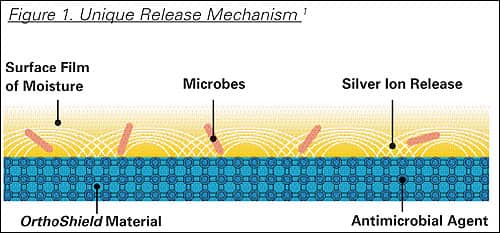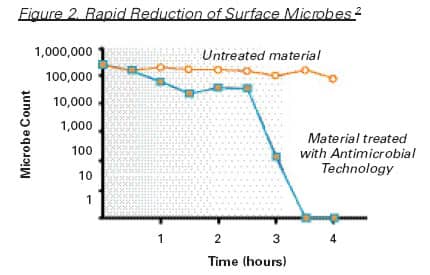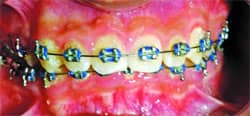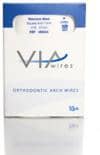by Maurice C. Corbett, DDS
How antimicrobial ligature ties help improve oral hygiene
-
- Maurice C. Corbett, DDS
The literature clearly demonstrates that the composition of subgingival microbiota can be influenced by several factors, including oral hygiene procedures and dental restorations. In a study by Andrea Natanjo, it was shown that changing the supragingival and subgingival environment with dental restorations and fixed orthodontic appliances could increase the amount of plaques formed around teeth.1 The same observation has been made around orthodontic bands and brackets.2 Fixed orthodontic appliances create a new retention area suitable for bacterial colonization. The frequencies of important periodontal microorganisms such as P. gingivalis, P. intermedia, and Fusobacterium species were higher after bracket installation than in the control patients. Also, periodontal pathogens such as T. forsythia, T. denticola, and P. nigrescens were significantly more prevalent in orthodontic patients than they were in controls. The complex interaction of these pathogens with the host modulates the host’s response, leading to inflammation, loss of attachment, and, eventually, a detrimental impact on the patient’s periodontium.
In a study by Forsberg,3 orthodontic patients whose teeth were ligated with an elastomeric ring exhibited a greater number of microorganisms in the plaque than teeth ligated with steel wire. Based on their recommendation, in patients with inadequate oral hygiene, the use of elastomeric ligation rings should be avoided.
In addition to health risks, poor oral hygiene is shown to increase the orthodontic treatment time.4 Specifically, patients with three or more “poor oral hygiene” entries had an additional 2.2 months of treatment, on average. It has been long understood that the cells involved in tooth movement, such as osteoclasts and osteoblasts, do not efficiently perform in an inflammatory environment. The developing monocytes fight a losing battle with inflammatory cells when this condition exists. The impact of this finding on patient satisfaction and practice management, although important, is beyond the scope of this article.
 |
| Figure 1: Schematics of OrthoShield Safe-T-Tie ligatures and release mechanism. |
The Compliance Issue
Given the above studies and importance of good oral hygiene, patient compliance still remains a big factor. Although numerous devices and products have been marketed to fight against inadequate oral hygiene, the orthodontist still needs to rely on the patient’s compliance to effectively use the products and follow the hygiene instructions.
One product that addresses the patient-compliance limitation is OrthoShield Safe-T-Tie ligatures by Ortho Organizers. OrthoShield Technology is based on the antimicrobial characteristics of naturally occurring silver.
 |
| Figure 2: OrthoShield effectively kills 99.9% of certain microbes within a few hours (provided by Ortho Organizers). |
These effects were first discovered in the 1860s. Silver’s highly effective bactericidal and fungicidal characteristics, combined with its low allergencity, have made it a good antimicrobial agent. Silver and other noble metals have long been recognized as potential allies in combating organisms, especially antibiotic-resistant bacteria in wounds.5 Silver nitrate and silver sulfadiazine have been used topically or in dressings to prevent or reduce infection in burn wounds.
Bacterial resistance to heavy metals like silver and mercury, although possible, is very rare. The majority of silver-resistant clinical isolates documented are from burn wounds, where silver sulfadiazine or silver nitrate was used in a topical cream.6 The OrthoShield Technology is embedded in a porous ceramic that controls the silver’s release to the surface of the elastomeric ring, providing additional safety measures against resistance while providing a durable antimicrobial solution (Figure 1).
In Vitro Antimicrobial Efficacy
-
- Figure 3: A 14-year-old male at the beginning of treatment.
The antimicrobial characteristic of silver is based on its ability to destabilize the bacterial cell wall, interrupt cell metabolism, and inhibit reproduction. Using these mechanisms, OrthoShield Technology lowers the count of certain organisms by 99.9% within a few hours (Figure 2). The ligatures provide continuous protection as long as the material remains in contact with the microbes, and will work for up to 30 days.
Clinical Efficacy
The sample patient shown here is a 14-year-old male participating in a blind study to demonstrate the clinical effectiveness of antimicrobial ligature ties.
On day 1, the patient has noticeably swollen, soft, red gums—a sign of gingivitis (Figure 3). At this time, the regular elastic ligature ties were replaced with antimicrobial ligature ties, and the patient was not given any additional hygiene instructions.
-
- Figure 4: 30 days post-treatment.
Thirty days postplacement, there are visible improvements to the gingival tissue (Figure 4). The redness and swelling are noticeably less. Ninety days postplacement, there are no visible signs of redness and swelling (Figure 5).
Considering the health risk associated with oral hygiene and the propensity of patients to have increased plaque and periodontal pathogens shortly after the start of orthodontic treatment, it is vital for orthodontists to consider an effective and fast method of controlling oral hygiene. By doing so, the orthodontist can help patients to have not only good oral health but a faster orthodontic treatment time.
-
- Figure 5: Approximately 90 days post-treatment
What practicing orthodontists need the most are tools that eliminate the patient-compliance factor from the treatment outcome. The OrthoShield Technology not only eliminates the need for lengthy hygiene instructions and expensive devices, it allows the clinician to obtain desired treatment results—even in severe cases in which, due to inadequate oral hygiene, the clinician was not able to use elastomeric ligatures.3
Overall, OrthoShield Safe-T-Tie Ligatures provide a safe and effective method of improving and managing poor oral hygiene in patients with low or no compliance. In a clinical setting, the ties improve the condition of the gingival lining in 30 days or less. For best results, I recommend that the orthodontist continue using them as a way to maintain the achieved oral hygiene and healthy gums.
Maurice C. Corbett, DDS, is in private practice in La Mirada, Calif. He is a past president of the California Society of Dentistry for Children. He is a cofounder of the Foundation for Advanced Continuing Education (FACE) and served as a consultant to the Army-Navy Orthodontic Training Program. He has lectured throughout the United States and 41 foreign countries. He can reached at
References
- Naranjo AA, Trivino M, Jaramillo A. Changes in the subgingival microbiota and periodontal parameters before and 3 months after bracket placement. Am J Orthod Dentofacial Orthop. 2006; 130(3):275.e17-22.
- Diamanti-Kipioti A, Gusberti FA, Lang NP. Clinical and microbiological effects of fixed orthodontic appliances. J Clin Periodontal. 1987;14:326-333.
- Forsberg CM, Brattstrom V, Malmberg E, Nord CE. Ligature wires and elastomeric rings: two methods of ligation, and their association with microbial colonization of Streptococcus mutans and lactobacilli. European J Orthod. 1991;13:416-420.
- Skidmore K, Brook K, Thompson M, Harding WJ. Factors influencing treatment time in orthodontic patients. Am J Orthod Dentofacial Orthop. 2006;129:230-238.
- Tredget EE, Shankowsky HA, Groeneveld A, Burrell R. A matched-pair, randomized study evaluating the efficacy and safety of Acticoat silver-coated dressing for the treatment of burn wounds. J Burn Care Rehabil. 1998;19:531-537.
- Davis IJ, Richards H, Mullany P. Isolation of silver and antibiotic-resistant Enterobacter cloacae from teeth. Oral Microbiology Immunology. 2005;20:191-194.













